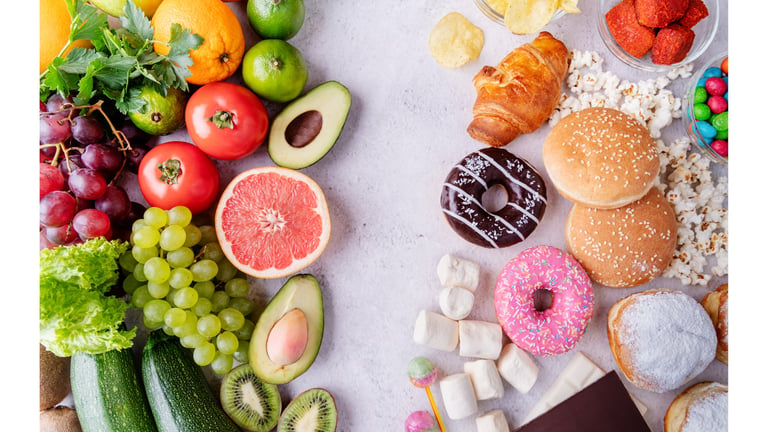Don't Fight Your Cravings, Decode Them: The Science of Listening to Your Body
PROACTIVE WELLNESS - PREVENTIONTHE KITCHEN CURE: GOOD FOOD, GOOD MOOD - NUTRITIONTRENDING!!


We’ve all been there. It’s 3 PM, and the urge for something salty and crunchy is overwhelming. Or it’s late at night, and all you can think about is chocolate. The common advice is to fight it, to use willpower. But what if your craving isn’t a weakness? What if it’s a message?
Welcome to the "Cravings Code." Your body is incredibly intelligent. It’s constantly sending you signals about what it needs. A craving is just one of those signals, and learning to interpret it is a cornerstone of Decoding Your Design. Instead of battling your body, you can partner with it.
Let's crack two of the most common codes:
The Salty Snack Craving: Before you demolish a bag of chips, pause. An intense craving for salt can be a sign of low electrolytes or adrenal fatigue, something students dealing with exam stress and professionals undergoing a health turnaround know all too well.
The Hack: Try a glass of water with a pinch of high-quality sea salt (like Celtic or Himalayan pink salt) and a squeeze of fresh lemon juice. This replenishes electrolytes and minerals. Wait 15 minutes and see how you feel.
The Chocolate Craving: Desperate for a chocolate bar? Your body might actually be crying out for magnesium. Magnesium is a vital mineral for relaxation and is often depleted by stress. Cacao (the raw form of chocolate) is one of the richest sources of magnesium.
The Hack: Instead of a sugary candy bar, try a handful of magnesium-rich almonds or pumpkin seeds, or a small piece of high-quality dark chocolate (70% cacao or higher).
By learning to listen, you steward your body with wisdom, not just willpower. You give it what it truly needs, leading to more energy, better mood, and a life that’s Rich in Wellness.
How to Decode Your Cravings: A Step-by-Step Guide
This isn't about restriction; it's about listening. Think of yourself as a detective learning the unique language of your body. Here’s how to start the investigation.
Step 1: Pause and Inquire. The moment a craving hits, stop. Before you react, take one deep breath and ask, "What's really going on?" Is it true physical hunger, or are you feeling bored, stressed, or sad? Acknowledging the feeling behind the craving is the first step in cracking the code.
Step 2: Identify the Sensation. Get specific. What texture or taste do you want? Is it salty, sweet, crunchy, creamy, or carby? A desire for crunchy food can signal frustration, while a craving for soft, creamy foods might be a call for comfort.
Step 3: Connect to the Potential Need. Use the clues from Step 2 to form a hypothesis. Salty? Could be electrolytes. Chocolate? Could be magnesium. Craving heavy carbs like bread and pasta? This is often a call for comfort and can signal a dip in the mood-regulating brain chemical, serotonin.
Step 4: Run the 15-Minute Experiment. Address the potential need first. Reach for the nutrient-dense "hack," not the processed snack. Drink the electrolyte water or eat the handful of almonds. Then, and this is crucial, wait 15 minutes. See if the craving subsides. This simple pause gives your body time to register the nutrients and gives you profound insight.
From Habit to Harmony: Making Permanent Changes
Decoding your cravings is a practice, not a one-time fix. Here’s how to integrate this wisdom into your daily life for lasting change.
Stock Your Toolkit: Make the healthy choice the easy choice. Keep your "hack" foods readily available. Have high-quality sea salt, lemons, almonds, pumpkin seeds, and dark chocolate visible and accessible. You're more likely to make a good choice when it's right in front of you.
Notice the Aftermath: Pay attention to how you feel 30 minutes after you eat. How do you feel after a bag of chips versus a handful of olives? How do you feel after a sugary candy bar versus a square of dark chocolate? Your body will give you honest feedback. Let that feeling of vitality (or sluggishness) be your guide for next time.
Embrace Consistency, Not Perfection: You won’t get it right every time, and that’s okay. The goal is not to be a perfect eater but to become a better listener. Each craving is a new opportunity to practice.
Tips & Tricks for Successful Decoding
Hydrate First, Always: Often, we mistake thirst for hunger. Before you decide it's a food craving, drink a large glass of water and wait a few minutes. This simple trick can dissolve a surprising number of cravings.
Address the Emotion: If you realize your craving is purely emotional, find a non-food solution. Feeling stressed? Do five deep belly breaths. Feeling bored? Put on your favorite song and dance for three minutes. Feeling lonely? Text a friend.
Don't Get "Hangry": When you're overly hungry, your blood sugar plummets, and your body will scream for the fastest possible energy source—usually sugar or refined carbs. Eating regular, balanced meals with protein, healthy fat, and fiber is the best defense against intense, desperate cravings.
The Benefits of Listening In
When you stop fighting and start decoding, you unlock a new level of well-being. The benefits go far beyond just eating healthier.
Stable, All-Day Energy: By giving your body the minerals and nutrients it actually needs, you sidestep the blood sugar rollercoaster that leaves you feeling wired one moment and exhausted the next.
A Deeper Body Trust: You move from a state of conflict with your body to one of partnership. This builds a profound sense of trust and self-awareness that ripples into all areas of your life.
Effortless Weight Management: When you satisfy your body on a cellular level, you're less likely to overeat empty calories, allowing your body to find its natural, healthy weight without force or restriction.
Improved Mood and Mental Clarity: Balancing minerals like magnesium and stabilizing blood sugar has a direct and powerful positive effect on your mood, focus, and ability to handle stress.
The Cravings Code Cheat Sheet: Try This, Not That
Keep this simple guide handy for when a craving strikes.
If you're craving... Salty & Greasy Chips
Not That: A bag of processed potato chips fried in inflammatory oils.
This: A glass of electrolyte water (water + pinch of sea salt + lemon), a handful of mineral-rich olives, or some crispy, homemade roasted chickpeas.
If you're craving... Sugary Milk Chocolate
Not That: A candy bar loaded with sugar and low-quality fats.
This: One or two squares of high-quality dark chocolate (70%+), magnesium-rich almonds or pumpkin seeds, or a warm mug of unsweetened cacao.
If you're craving... Heavy Carbs (Bread, Pasta, Crackers)
Not That: A sleeve of refined crackers or a bowl of white pasta that will spike your blood sugar.
This: A serving of complex carbohydrates like a small baked sweet potato, a bowl of quinoa, or a slice of sprouted-grain toast with avocado and sea salt.
If you're craving... Sugary Candy or Soda
Not That: A bag of gummy candy or a can of soda.
This: A piece of whole fruit like a crisp apple or a handful of sweet grapes, sparkling water with a splash of pomegranate juice, or a cup of naturally sweet herbal tea (like licorice or cinnamon).
If you're craving... Creamy Ice Cream
Not That: A pint of store-bought ice cream with a long list of artificial ingredients.
This: A creamy "nice cream" made by blending a frozen banana with a splash of almond milk, or a bowl of full-fat Greek yogurt with berries.
If you're craving... Fried Foods
Not That: Fast-food french fries or other items cooked in processed vegetable oils.
This: Foods rich in healthy fats like sliced avocado with sea salt and lime, or homemade sweet potato "fries" baked with avocado oil and spices.
If you're craving... A Caffeinated Energy Drink
Not That: A sugary, artificial energy drink that guarantees a crash later.
This: A cup of green tea (for calm, focused energy), a tall glass of ice water with mint, or a five-minute walk outside to reset your system.
Your Body Is Your Partner, Not Your Problem
Ultimately, decoding your cravings is about changing the conversation. It’s a shift away from seeing your body as something to be tamed, controlled, and fought against. It’s a move toward a partnership built on respect, curiosity, and trust.
When you begin to listen—truly listen—you’ll find that your body has been on your side all along. It has been sending you messages in the only way it knows how. By learning its language, you are not just "eating healthy"; you are engaging in a profound act of self-care and becoming the wisest steward of your own well-being. This is the foundation of Decoding Your Design.
Your Challenge This Week:
I invite you to become a craving detective. Pick one recurring craving that you often struggle with. The next time it appears, don't fight it and don't immediately indulge it. Instead, run through the four steps: Pause, Identify, Connect, and Experiment.
What do you discover? What message might your body be sending you?
Share your experience in the comments below! Your insight might be the key that helps someone else crack their own code. Together, we can all become a little more fluent in the language of our bodies and live a life that is truly Rich in Wellness.


